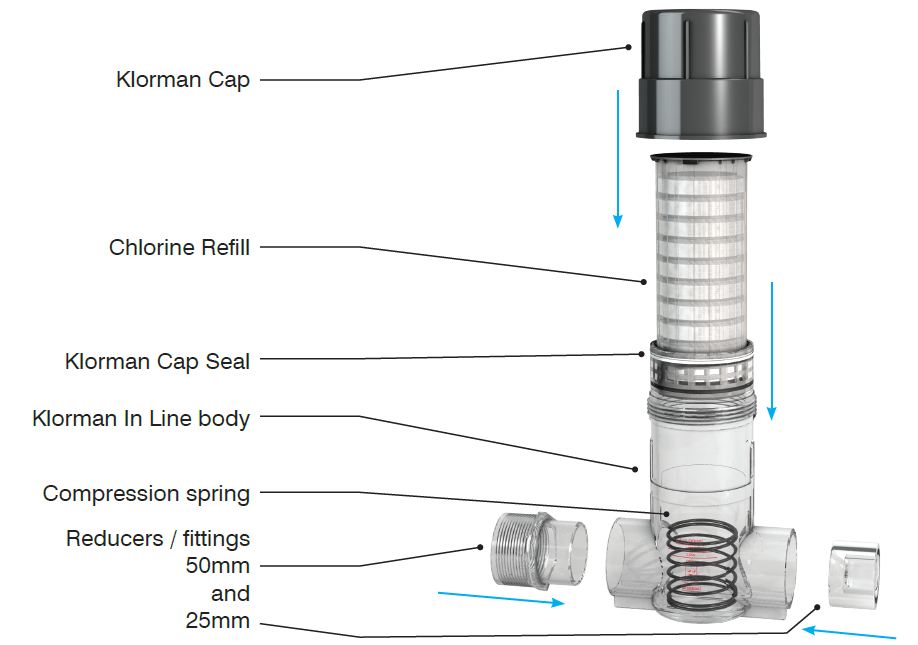Klorman Inline Chlorinator
The Klorman Inline Chlorinator would be installed on a water line, as the water flows through the unit small amounts of the chlorine tablets dissolve into the water and are carried away with the water.
The Level of chlorine being added is controlled by a spring, which lowers or raises the chlorine cartridge into the flow of incoming water. The lower the cartridge the more tablets are exposed to the water and the larger the dosage, the higher the cartridge the fewer tablets are exposed and the dosage level is lower.
The Chlorine cartridges hold a total of 10 Chlorine tablets each.
The Life span of the chlorine cartridges differs from application to application and is dependent on a number of variables including:
- Quality of the source water
- Flow rate (liters per hour)
- The Dosage level set on the unit
Components and parts for Inline Chlorinator

Installation of Inline Chlorinator
There are two options for installing the Chlorinator, either you can install the unit directly inline or alternatively you can install the unit with a bypass setup. The Bypass setup will allow you to have more control of the unit, allowing you to "disconnect" the chlorinator without stopping the main flow.
Inline Installation setup

Bypass Installation setup

Replacement Chlorine Cartridges
The Replacement Chlorine Cartridges are available in the following amounts:
- Single Chlorine Cartridge
- Box of 4 Chlorine Cartridges (Box Dimension 18cm x 18cm x 23cm / 3.5kg)
- Box of 8 Chlorine Cartridges (Box Dimension 36cm x 18cm x 23cm / 7kg)
- Box of 16 Chlorine Cartridges (Box Dimension 38cm x 37cm x 24cm / 14.8kg)
Complete Water Treatment Solution
With treating water you normally need quite a few different components working together. This product is just one of those components and most likely will not be enough on its own. We have a team of experts that can advise you on what you need to get your water to a good quality. Alternatively, our Borehole Water Section is a good place to start as it has videos explaining the various areas that normally needs to be addressed to treat water.
PVC Threaded and Glue Fittings
PVC(Polyvinyl chloride) fittings are used to connect sections of pipes or tubes, adapt to different sizes or shapes, and controlling the flow of water. There are two predominant types of PVC fittings namely PVC Glue Fittings and PVC Threaded Fittings. The difference between the two is that PVC Glue Fittings result in permanent joints and PVC Threaded Fittings are semi-permanent and can be replaced. PVC Glue fittings are joined with primer and cement- a chemical solvent that melts the surface of the PVC and then quickly re-hardens to fuse the pieces together. This results in an airtight, leak-proof bond similar to what you get with welding metal. An example of such a fitting is a PVC Glue Reducing Socket which is used to join together two pieces of PVC pipes with different diameters. Another example would be a 90 Degree Elbow which is used to connect two pipes of the same diameter at an angle of 90 degrees.PVC Threaded fittings utilise a simple threaded connection whereby replaceable 'male threaded' are screwed into 'female threaded'.Male threads have a thread on the outside of the fitting and female threads have a thread on the inside. When you thread the fitting in, it compresses against the other threads.PTFE tape is used to thread these together and the proper way to assemble threaded fittings is to finger tighten, then add one to two turns but no more. An example of a threaded fitting is a Reducing Nipple Male Threaded which is used to connect between two female threads of different diameters.
Link To PVC Fittings
























































